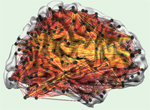Monday, 21 March 2016
Awareness as a Temporary Breakdown of the Brain’s Functional Networks

When you become consciously aware of something, what exactly is happening in your brain? Or stated differently, is there a geography of neuronal connections that is specific to becoming aware of a stimulus (for instance, a stimulus that is presented very briefly, so that you may or may not become aware of it)?
This is not a new question. It amounts to asking whether there are particular brain networks that are essential to awareness, or whether awareness instead emerges from the connectivity of large areas of our sensory and associative cortexes. This latter, global approach received support from a study published in March 2015 in the Proceedings of the National Academy of Sciences of the United States of America, entitled “Breakdown of the brain’s functional network modularity with awareness”, by Douglass Godwin and two collaborators.
In this study, the authors briefly presented their subjects with an image, then analyzed the functional connectivity of the brains of those subjects who reported having consciously perceived the image. What the authors observed in these cases was a sudden reduction in the functional modularity of the brain and a corresponding increase in large-scale neuronal communication throughout the brain’s circuits.
We should note here that scientists already know that there is no “awareness centre” in the brain, just as there is no “centre” for fear or for anything else. But the brain does have what are known as functional networks, meaning somewhere between 5 and 20 areas that tend to modify their activity together in certain situations. A number of such networks have been identified, and some of them have even been given names, such as the dorsal attention network, the control network, and the default mode network.
To draw an analogy, when you ask Google Maps for directions between two cities, it offers you one route—typically the shortest—through the highway network, but often also offers you one or two longer, alternative routes. Just as the highway network does for vehicles, the anatomical network of your brain’s neuronal pathways offers nerve impulses a variety of different routes that they can travel. Unlike anatomical imaging methods such as diffusion MRI, functional connectivity imaging attempts to show which of the possible routes a nerve impulse is actually travelling. And just as drivers often prefer certain routes, functional connectivity imaging shows that nerve impulses often travel certain preferred paths as well.
When you consciously perceive a stimulus, it is the boundaries of these individual circuits, sometimes known as brain modules, that tend to break down, while the connectivity of large regions of the cortex increases. Thus conscious awareness seems to be more like an orchestra playing a symphony than one instrument playing a solo.
This musical metaphor is fairly consistent with certain “global” theories of consciousness, such as the neuronal workspace proposed by Bernard Baars, or the integrated information theory of Giulio Tononi.
These results are also consistent with the unified way that we actually experience our world. Just as we do not, for instance, experience a visual world juxtaposed on an auditory world, the brain activity that occurs when we have a global conscious perception of an object involves highly multimodal connectivity, engaging both the sensory and the associative regions of the brain. Thus we perceive the object’s colour, texture, odour, and sound simultaneously.
But before you assume that the global approach to awareness is completely true and the local approach is completely false, remember that in the brain, nothing is that simple. For example, one study published in 2014 suggested that the claustrum, a subcortical structure that is connected with practically every other part of the brain, may act somewhat like an ON/OFF switch for consciousness, because when the researchers stimulated this structure electrically, their subjects became unconscious instantly.
![]() Network theory suggests consciousness is global in the brain
Network theory suggests consciousness is global in the brain
![]() State Of Mind: Network Theory Suggests Consciousness Is Global In the Brain, Rises From Cooperative Activity
State Of Mind: Network Theory Suggests Consciousness Is Global In the Brain, Rises From Cooperative Activity
![]() Breakdown of the brain’s functional network modularity with awareness
Breakdown of the brain’s functional network modularity with awareness
![]() Electrical stimulation of a small brain area reversibly disrupts consciousness
Electrical stimulation of a small brain area reversibly disrupts consciousness
The Emergence of Consciousness | No comments







